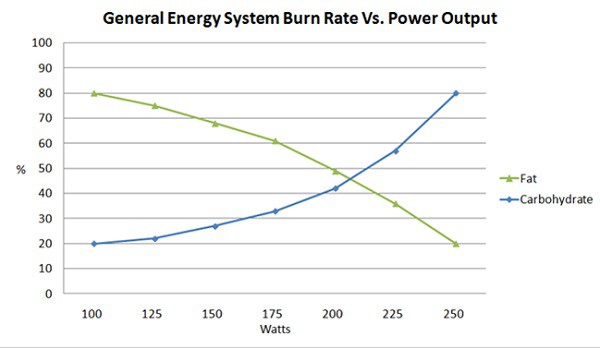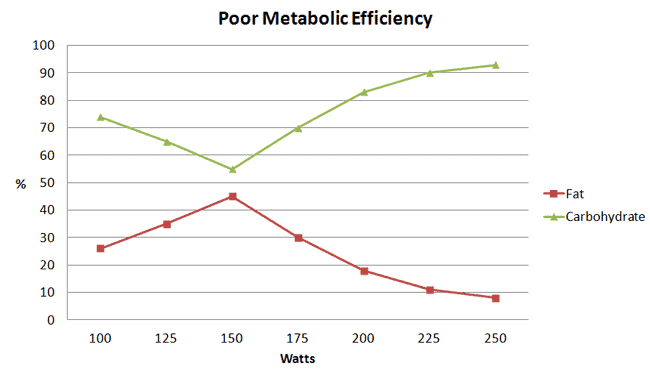Cycling metabolic efficiency is the ability to burn more of your fat reserves at higher exercise intensities. If you are a racing cyclist or a serious recreational rider, then improving your metabolic efficiency is something that we highly recommend. It will improve your overall performance on the bike and is particularly important for us as cyclists because a lot of our training rides and events are longer than two hours.
Improving your metabolic efficiency helps you as a cyclist in five important ways:
- It will help to reduce the reliance on consuming large amounts of carbohydrate while on rides lasting longer than two hours
- You will no longer need to consume carbohydrate during a ride lasting less than two hours
- You improve your ability to be “bonk-proof”, that is, you reduce the chance of bonking on rides.
- You can produce more constant “tempo power” during your rides without the risk of fading, meaning that you can ride faster, for longer and not feel like you need to be constantly eating.
- You burn more of your fat stores while out on the bike, so with the right eating plan, you have the potential to lose weight more quickly. Which means that you’ll be able to drop to between your ideal and absolute minimum cycling bodyweight quickly.
So how does metabolic efficiency work?
The way that you burn energy is very important. The blend ratio of fat to carbohydrate that you use varies depending on the intensity that you ride at.
When you ride at an easy pace (low power outputs), you burn a higher percentage of fat to carbohydrate. As you increase your intensity and ride faster, you produce more power on the bike. When you do this, the ratio of fat to carbohydrate changes and you start burning a higher percentage of carbohydrate to fat. See figure 1.
Figure 1 General percentage of fat to carbohydrate burn rates based on cycling intensity (in watts)
Ninety minutes is an important factor to do with being metabolically efficient.
A seasoned cyclist will have enough carbohydrate stored in their bodies to provide them with around ninety minutes of high-intensity cycling. This can be extended up to several hours when cycling at lower intensities. The amount of time it takes to bonk is relative to the metabolic efficiency of the rider and how intensely they are riding.
Once we have consumed this carbohydrate storage we will “bonk”, or in running terms; “hit the wall”.
The onset of bonking comes on very rapidly. It only takes around two to three minutes to go from riding very well at high intensities to not being able to ride faster than around 12 km/h, or not at all. The reason for this is that we are not able to metabolise our pure fat reserves fast enough to provide the muscles with enough energy to drive them back up to ride at high intensities. Unfortunately, you won’t know when you are just about to “bonk” as there is no prewarning. It just happens, and you go from riding well to riding pretty ordinary in just a few moments.
No amount of willpower will enable you to push through the laws of metabolising energy. When you run out of carbohydrate, you can only ride slowly, nothing more. The results can be disastrous if you are racing or riding a long recreational event.
The only way to recover is to consume a HIGH-GI carbohydrate like a gel and wait 15-25 minutes before you have your carbohydrate storage replenished enough for you to continue.
So that is why we need to consume a carbohydrate when riding for longer than two hours and before we bonk.
Many cyclists misinterpret the gradual performance fall off during a long endurance ride as bonking. This gradual decrease in performance is more likely caused by general fatigue due to poor preparation and fitness leading up to the event rather than running out of carbohydrate and bonking. It’s important to understand the distinction between bonking and general fatigue when understanding your nutritional requirements. But if you experience these fades during your riding, you may find that improving your overall metabolic efficiency will help you.
But if our metabolic efficiency is poor, you may find that you are so bad at metabolising fat that you can’t even get through a ride that’s less than two hours without fading and “bonking”. And this is common in athletes that haven’t trained themselves to burn fat at high levels of intensity.
In the 1980s when the marathon craze hit the world, many people suffered from hitting the wall in the closing km of their run. As a result, complex carbohydrate loading protocols that took months to work through were developed to combat “hitting the wall”. Over the years these have been bastardised into just consuming large amounts of carbohydrate in the final days leading up to a race or event to help “store” as much carbohydrate in their bodies could handle before the event. This form of carbohydrate loading is fundamentally flawed and will only provide a very marginal improvement in performance, if any at all, on the day of your event. Unfortunately, many cyclists continue to pursue this practice today.
The problem lies in how effectively we metabolise our energy stores, rather than trying to load us up with carbohydrates before an event. Unfortunately, cyclists that live on a diet rich in high Glycogen Index (GI) carbohydrate tend to exhibit a poor metabolic efficiency.
Figure 2 provides an example of the burn ratios of carbohydrate and fat in these cyclists. As you can see this cyclist has a very poor ability to use fat as a primary energy source and relies heavily on carbohydrate as an energy source for much of their cycling at most intensities. This cyclist has a very high chance of bonking and will need to consume large amounts of carbohydrate during their endurance rides to ensure that they maintain their carbohydrate levels.
Figure 2 Example of poor metabolic efficiency in a cyclist
How to Improve Your Metabolic Efficiency.
A better way to deal with reducing the chance of bonking is to work on improving the efficiency of burn ratio between carbohydrate and fat. It’s called improving metabolic efficiency and is a far more successful protocol to adopt. The metabolic efficiency adaption takes around six to eight weeks; the result is a curve like the one shown in Figure 1. In this case, the cyclist has lifted their ability to burn more fat at higher intensities that enable them to become less reliant on consuming a large amount of carbohydrate during their long endurance rides. It also makes them leaner, with less weight their power to weight ratio improves and therefore they are faster on the climbs.
Increasing the glycogen storage through carbohydrate loading is one way to increase the time it takes to bonk or hit the wall. But as mentioned, it’s only going to provide marginal gains, if any. It’s also not very relevant if you plan to ride more than two hours.
Another way that many cyclists have tried to improve their metabolic efficiency is to reduce the amount of overall carbs they introduce into their diet. But again, this causes many issues because as endurance athletes we still need to fuel the body with carbohydrates when on rides longer than two hours. If you cut out too many, your overall cycling performance will drop off dramatically. And, if you have too many carbs in your diet, you won’t stimulate the adaptation need to become metabolically efficient.
The process to get your body to become metabolically efficient is more complex than just cutting out carbs from your diet. This is because we need to consider the impact of nutritional timing. What we eat and when we eat it, plays an incredibly important part of the process of becoming metabolically efficient. This is because we need to balance our energy needs for when we are training and when we are not. And, it needs to line up against our training program so that the two are in sync.
Our energy needs change not only for when we are training and when we are not, but also change depending on the type and length of the workout we are doing. When we get this balance right, we have the energy available to us when we need it. This is important because, as mentioned, if we don’t get it right our cycling performance will drop off dramatically if we cut too many carbohydrates from our diet.
Over the last three years, we have developed the Leaner Cyclist program that provides simple and healthy eating plans and recipes, combined with time efficient structured training programs that work together. They enable you to not only improve your performance and lift your FTP but also your metabolic efficiency.
One of the massive side effects of the Leaner Cyclists program is that it also helps you quickly trim down to between your ideal and your absolute minimum cycling bodyweight. This is because being a metabolically efficient cyclist turns you into an absolute fat burning machine.
Where to go to for more help
- Click here to use our calculator to work out your ideal and absolute minimum cycling weight
- Click here to find out how to improve your power to weight
- Click here for more eating plans and recipes to help you lose weight
- Click here to find out how to become a leaner cyclist
- Click here to learn how to burn up to 300% more fat while cycling
- How To Get Your Nutrition Right For Longer Rides








Leave A Comment